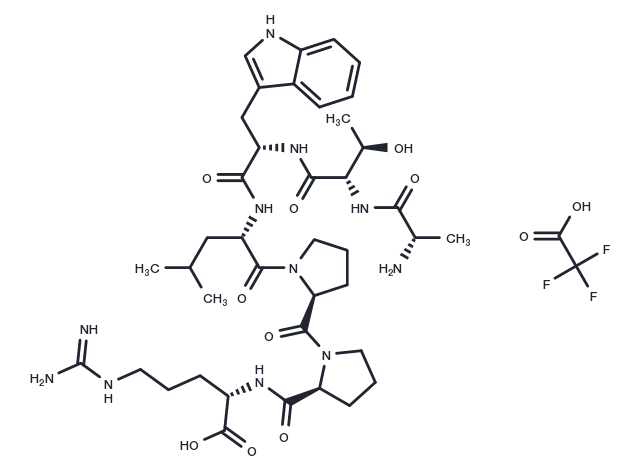Powder: -20°C for 3 years | In solvent: -80°C for 1 year


ATWLPPR Peptide TFA is a selective neuropilin-1 inhibitor and inhibits VEGF165 binding to NRP-1. It has the potential in reducing the early retinal damage caused by diabetes.

| Pack Size | Availability | Price/USD | Quantity |
|---|---|---|---|
| 50 mg | Inquiry | Inquiry | |
| 100 mg | Inquiry | Inquiry |
| Description | ATWLPPR Peptide TFA is a selective neuropilin-1 inhibitor and inhibits VEGF165 binding to NRP-1. It has the potential in reducing the early retinal damage caused by diabetes. |
| In vitro | ATWLPPR Peptide TFA inhibits VEGF165 binding to NRP-1 by 82% at 100 μM [1]. |
| In vivo | ATWLPPR (400 μg/kg, s.c.) maintains vascular integrity and reduces oxidative stress, potentially mitigating early diabetic-related retinal damage. It inhibits the elevation of inflammation-associated proteins (GFAP, VEGF, and ICAM-1) in the retina [2]. |
| Molecular Weight | 954 |
| Formula | C42H62F3N11O11 |
| CAS No. | T10408 |
Powder: -20°C for 3 years | In solvent: -80°C for 1 year
H2O: 50 mg/mL (52.41 mM)
You can also refer to dose conversion for different animals. More
bottom
Please see Inhibitor Handling Instructions for more frequently ask questions. Topics include: how to prepare stock solutions, how to store products, and cautions on cell-based assays & animal experiments, etc.
ATWLPPR Peptide TFA T10408 Others inhibitor inhibit
